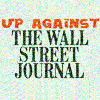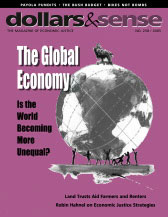
Free, Free at Last
Economic freedom for corporations has little to do with either political freedom or economic growth.
This article is from the March/April 2005 issue of Dollars and Sense: The Magazine of Economic Justice available at http://www.dollarsandsense.org

This article is from the March/April 2005 issue of Dollars & Sense magazine.
Subscribe Now
at a discount.
Hail Estonia!
For the first time in the 11 years that the Heritage Foundation and The Wall Street Journal have been publishing the Index of Economic Freedom, the U.S. has dropped out of the top 10 freest economies in the world. …
The 2005 Index, released today, ranks Hong Kong once again as the world's freest economy, followed by Singapore and Luxembourg. But it is Estonia at No. 4 that makes the point. This former Soviet satellite is a model reformer, setting the standard for how fast countries can move ahead in the realm of economic liberalization. …
The U.S. … scores well. But worrying developments like Sarbanes-Oxley in the category of regulation and aggressive use of antidumping law in trade policy have kept it from keeping pace with the best performers in economic freedom. Most alarming is the U.S.'s fiscal burden, which imposes high marginal tax rates for individuals and very high marginal corporate tax rates. …
Policy makers who pay lip service to fighting poverty would do well to grasp the link between economic freedom and prosperity. This year the Index finds that the freest economies have a per-capita income of $29,219, more than twice that of the "mostly free" at $12,839, and more than four times that of the "mostly unfree." Put simply, misery has a cure and its name is economic freedom.
--Wall Street Journal op-ed by Mary Anastasia O'Grady, January 4, 2005
I must be confused. I somehow thought that an Economic Freedom Index would showcase countries that are reducing the democratic deficits of the global economy by giving people more control over their economic lives and the institutions that govern them. In the hands of the Wall Street Journal and the Heritage Foundation, Washington's foremost right-wing think tank, however, an economic freedom index merely measures corporate and entrepreneurial freedom from accountability. Upon examination, the index turns out to be a poor barometer of either freedom more broadly construed or of prosperity.
The index does not even pretend that its definition of economic freedom has anything to do with political freedom. Take the two city-states, Hong Kong and Singapore, which top the index's list of free countries. Both are only "partially free" according to Freedom in the World, an annual country-by-country assessment published by the nonpartisan think tank Freedom House, which the Journal's editors themselves have called "the Michelin Guide to democracy's development." Hong Kong is still without direct elections for its legislature or its chief executive, and a proposed internal security law threatens press and academic freedom as well as political dissent. In Singapore, freedom of the press and the right to demonstrate are limited; films, TV, and other media are censored; preventive detention is legal; and you can do jail time for littering.
Moving further down the list of "free" countries, the rankings are no better correlated with any ordinary definition of "freedom," as economic journalist Robert Kuttner pointed out when the index was first published in 1997. For instance, Bahrain (#20), where the king holds an effective veto over parliament and freedom of expression is limited, ranks higher than Norway (#29), whose comprehensive social insurance and strong environmental regulation drag down its score. Likewise, Kuwait, an emirship no one would term free or democratic, is tied (at #54) with Costa Rica, long the most vigorous democracy in Latin America.
These results are not surprising, however, given the index's premise: the less a government intervenes in the economy, the higher its freedom ranking. Specifically, the index breaks "economic freedom" down into 10 components: trade policy; fiscal burden of government; level of government intervention; monetary policy; financial liberalization; banking and finance policies; labor market policies; enforcement of property rights; business, labor, and environmental regulations; and size of the black market. In other words, minimum-wage laws, environmental regulations, or requirements for transparency in corporate accounting make a country less free, whereas low business taxes, harsh debtor laws, and little or no regulation of occupational health and safety make a country more free.
Consider that the index docks the United States' ranking for passing Sarbanes-Oxley, a law that seeks to improve corporate accounting practices and to make CEOs responsible for their corporations' profit reports. The segment of the U.S. population whose economic freedom this law erodes is tiny, but it's obviously that segment--not workers and not even shareholders--whose freedom counts for the folks at the Journal and at Heritage.
The rather objective-looking list that results from assessing the 10 components ranks 155 countries from freest (Hong Kong and Singapore) to most repressive (Burma and North Korea). The index then becomes a tool its authors can use to hammer home their message: economic freedom (as they define it) brings prosperity. As they point out, "the freest economies have a per-capita income more than twice that of the ‘mostly free' and more than four times that of the ‘mostly unfree.'"
Not so fast. For one thing, the index's creators used some oddball methods that compromise its linkage of prosperity to economic freedom.
For instance, according to the index, the fiscal burden of the Swedish and Danish welfare states is smaller than that of the United States, even though U.S. government spending is more than 20 percentage points lower relative to Gross Domestic Product (GDP, or the size of the economy). This bizarre result comes about because the index uses the change in government spending, not its actual level, to calculate fiscal burden.
To measure the tax side of a country's fiscal burden, the index uses the top rate of the personal and corporate income taxes--and that's equally misleading. Besides ignoring the burden of other taxes, these two figures don't get at effective tax rates, which also depend on what share of corporate profits and personal income is actually taxed. On paper, U.S. corporate tax rates are higher than those in Europe, as the Journal is quick to point out. But nearly half of U.S. corporate profits go untaxed. The average rate of taxation on U.S. corporate profits currently stands at 15%, far below the top corporate tax rate of 35%. And relative to GDP, U.S. corporate income taxes are no more than half those of other OECD countries.
The index's treatment of government intervention is flawed as well, for it fails to count industrial policy as a form of intervention. This is a serious mistake: it means that the index overestimates the degree to which some of the fastest growing economies of the last few decades, such as in Taiwan and South Korea, relied on the market and underestimates the positive role that government played in directing economic development in those countries by guiding investment and protecting infant industries.
The treatment of informal markets is downright strange. The index considers a large informal sector to indicate less economic freedom because government restrictions must have driven that economic activity underground. (Of course, you could take the opposite view: since the informal sector is for the most part unregulated, countries with larger informal sectors are, by the index's definition, more free!) But this way of looking at it biases the index. Developing countries tend to have large informal sectors while developed economies usually have small informal sectors. That means the index systematically lowers the economic freedom index of developing countries while boosting the scores of developed countries, thus artificially correlating income levels with economic freedom. Even right-wing economist Stefan Karlsson of the libertarian Ludwig Von Mises Institute has criticized the index on this point. Thanks in part to this bias, Estonia, Chile, and Bahrain are the only middle-income countries to make it into the top 20.
Whatever the biases in the index do to cement a tight relationship between economic freedom and income, they can't produce a tight correlation between economic freedom and growth. The fastest-growing countries are mostly unfree. Take China, India, and Vietnam, three of the fastest-growing countries in the world. They are way down in the rankings, at #112, #118, and #137 respectively. While all three countries have adopted market reforms in recent years that have improved their standing in the index, their trade policies and regulations remain "repressive." And there are plenty of relatively slow growers among the countries high up in the index, including Estonia (#4), the Journal's poster child for economic freedom. How free or unfree a country is according to the index seems to have little to do with how quickly it grows.
An "Economic Freedom Index" that tells us little about economic growth or political freedom is a slipshod measure that would seem to have no other purpose other than to sell the neoliberal policies that stand in the way of most people gaining control over their economic lives and obtaining genuine economic freedom in today's global economy.
Resources Mary Anastasia O'Grady, "Hail Estonia!" Wall Street Journal, 1/4/05; The 2005 Index of Economic Freedom (Heritage Foundation, 2005); Johan Fernandez, "Malaysia climbs up economic freedom index," The Star Online, 1/25/05; "Freedom & Growth: No Siamese twins," The Economic Times, 5/27/02; Robert Kuttner, "A Weird Set of Values," The American Prospect, 12/7/97; Stefan M. I. Karlsson, "The Failings of the Economic Freedom Index," (Ludwig Von Mises Institute, 1/21/05); "Freedom in the World 2005: Civic Power and Electoral Politics," (Freedom House, 2005) <www.freedom house.org/research/survey2005.htm>.
